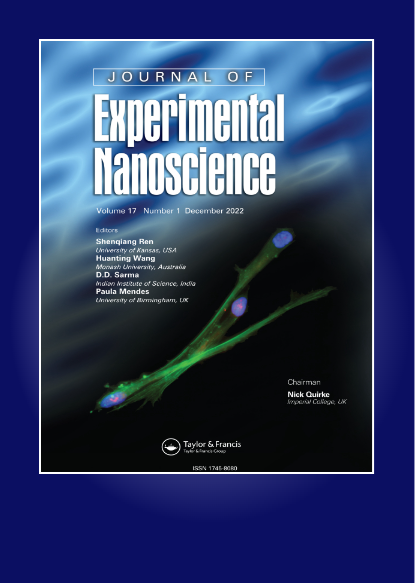金盏花叶水提物绿色合成铁纳米颗粒对米托蒽醌诱导的HDMVECn、HUVEC、HAEC、HCAEC、HCASMC和HPAEC细胞DNA断裂和凋亡的心血管保护作用
IF 2.6
4区 材料科学
Q2 CHEMISTRY, MULTIDISCIPLINARY
引用次数: 4
摘要
摘要本研究以金盏菊提取物为稳定剂和还原剂,在水介质中合成铁纳米颗粒。合成的纳米颗粒(FeNPs)使用不同的技术进行了表征,包括UV-Vis。以及FT-IR光谱、X射线衍射(XRD)、扫描电子显微镜(SEM)和能量色散X射线光谱(EDS)。XRD分析表明,FeNPs的晶粒尺寸为34.29 nm。SEM图像显示,生物合成的纳米颗粒呈均匀的球形,尺寸为46.30 nm。TUNEL试验显示细胞凋亡和DNA断裂。罗丹明123荧光染料检测线粒体膜电位。纳米铁颗粒处理的细胞切割器减少了DNA断裂。他们提高了高浓度米托蒽醌处理的HDMVECn、HUVEC、HAEC、HCAEC、HCASMC和HPAEC细胞的线粒体膜电位。高剂量的铁纳米颗粒(即4µg)具有最佳的心血管保护效果。综上所述,含金盏花叶水提物的铁纳米颗粒经人体临床试验批准后,可作为心血管疾病的心血管保护补充剂给药。本文章由计算机程序翻译,如有差异,请以英文原文为准。
Cardiovascular protective properties of green synthesised iron nanoparticles from Calendula officinalis leaf aqueous extract on Mitoxantrone-induced DNA fragmentation and apoptosis in HDMVECn, HUVEC, HAEC, HCAEC, HCASMC and HPAEC cells
Abstract In this study, iron nanoparticles were synthesised in aqueous medium using Calendula officinalis extract as stabilising and reducing agents. The synthesised nanoparticles (FeNPs) were characterised using different techniques, including UV–Vis. and FT-IR spectroscopy, X‐ray diffraction (XRD), scanning electron microscopy (SEM) and Energy Dispersive X-ray Spectrometry (EDS). According to the XRD analysis, 34.29 nm was measured for FeNPs crystal size. SEM images exhibited a uniform spherical morphology in size of 46.30 nm for the biosynthesized nanoparticles. TUNEL test was used to show apoptosis and DNA fragmentation. The mitochondrial membrane potential was studied by Rhodamine123 fluorescence dye. Iron nanoparticles-treated cell cutlers decreased the DNA fragmentation. They raised the mitochondrial membrane potential in the high concentration of Mitoxantrone-treated HDMVECn, HUVEC, HAEC, HCAEC, HCASMC and HPAEC cells. The best result of cardiovascular protective properties was seen in the high dose of iron nanoparticles, i.e. 4 µg. According to the above findings, iron nanoparticles containing Calendula officinalis leaf aqueous extract may be administrated as a cardiovascular protective supplement for treating cardiovascular diseases after approving in the clinical trial studies in humans.
求助全文
通过发布文献求助,成功后即可免费获取论文全文。
去求助
来源期刊

Journal of Experimental Nanoscience
工程技术-材料科学:综合
CiteScore
4.10
自引率
25.00%
发文量
39
审稿时长
6.5 months
期刊介绍:
Journal of Experimental Nanoscience, an international and multidisciplinary journal, provides a showcase for advances in the experimental sciences underlying nanotechnology and nanomaterials.
The journal exists to bring together the most significant papers making original contributions to nanoscience in a range of fields including biology and biochemistry, physics, chemistry, chemical, electrical and mechanical engineering, materials, pharmaceuticals and medicine. The aim is to provide a forum in which cross fertilization between application areas, methodologies, disciplines, as well as academic and industrial researchers can take place and new developments can be encouraged.
 求助内容:
求助内容: 应助结果提醒方式:
应助结果提醒方式:


